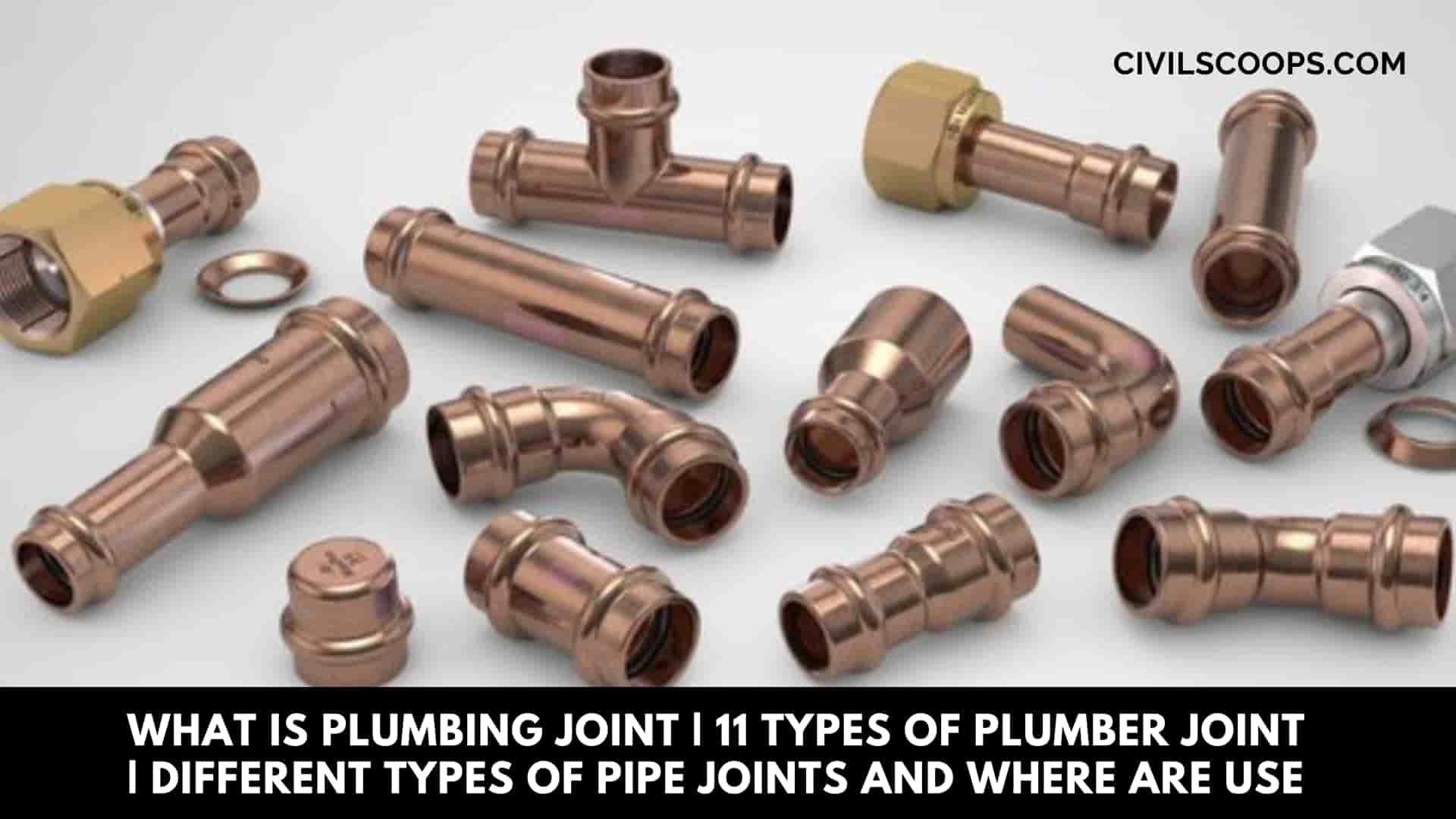
Table of Contents
What Is Plumbing Joint?
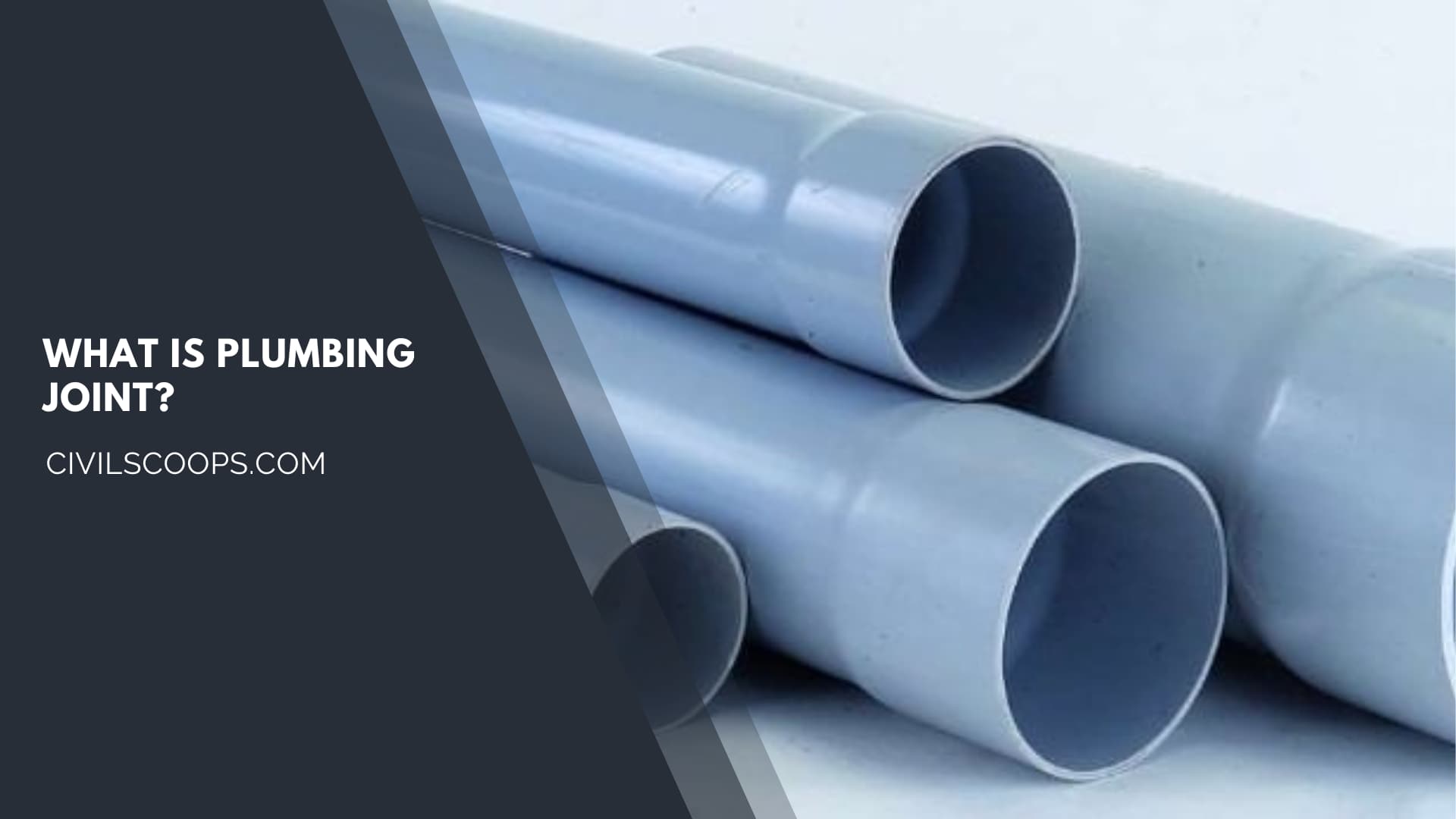
Pipes are connected with the help of joints. A variety of joints are used in an assembly of pipes. Connecting two or more pipes together is called a fitting. Various types of joints could be used in a pipe as per the requirement.
Joints are also used for multiple pipe connections and are an important component of the plumbing system. Generally, the pipe joint fitted can easily sustain the pressure created in the pipe.
Types of Pipe Joint.

- Threaded Joint.
- Brazed Joint.
- Spigot and Socket joint.
- Socket Welded Joint.
- Soldered Joint.
- Welded Joint (Butt Welded, Socket Welded)
- Flanged Joint.
- Compression Joint.
- Grooved Joint.
- Push-Fit Joint.
- Hep2o Joint.
1. Threaded Joint
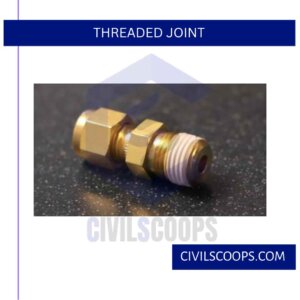
Threaded joint means, pipes are connected by screwing with the help of threads provided for each pipe. One pipe having internal threads and the other one having threads externally. Cast iron pipes, copper pipes, PVC and G.I pipes are available with threads.
Thread joints are available from 6 mm diameter to 300mm diameter pipes.They are preferable for low temperature, the joints may expand and leaked due to thermal expansion. Installation of threaded joint id easy but good maintenance required.
2. Brazed Joint
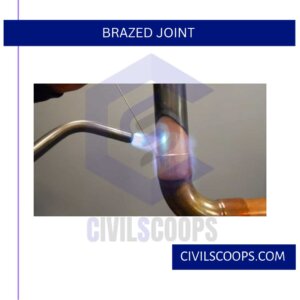
Brazed joints are generally used to achieve higher joint strength or fatigue resistance. To accomplish this, filler metals stronger than those composed primarily of tin must be used.
However, this increased strength generally comes from filler metals made of materials that melt at higher temperatures.
3. Spigot and Socket Joint
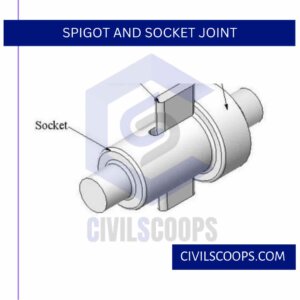
A spigot joint is a type of pipe fitting connection that is inserted into another pipe fitting. The spigot end typically has the same outer diameter as the pipe and is usually fitted into another joint called a bell or socket. Together, these two elements form what is commonly known as a bell and spigot joint.
Spigot and Socket Joint: Sometimes this is called bell and spigot joint. This type of joint is mostly used for cast iron pipes.
For the construction of this joint, the spigot or normal end of one pipe is slipped in socket or bell end of the other pipe until contact is made at the base of the bell.
4. Socket Welded Joint
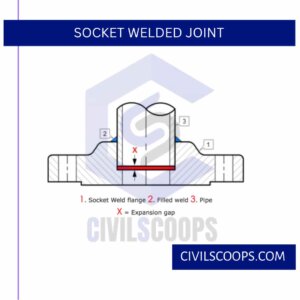
It is one of the most common methods of joining pipes used in large infrastructure like a commercial, institutional and industrial systems.
The cost of material is low, but the labour costs are more due to the non-availability of trained welders and fitters.
5. Soldered Joint
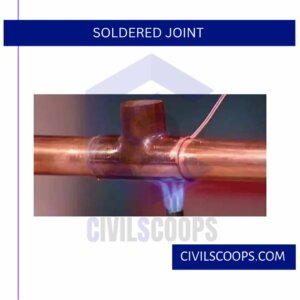
Soldered joints are material-closed joints (bonds) of two solderable metals. There are different forms of soldered joints. Wire-to-wire joints as parallel, cross or hook joints as well as soldered joints with twisted wires. Parallel and cross joints are mechanically connected by the solder only and, therefore, can be more easily detached.
The joint is heated above the melting-point temperature of the solder by means of the soldering iron and bonded with soldering tin added. Then the soldered joint must cool down with no displacement of the wires.
6. Welded Joint (Butt Welded, Socket Welded)
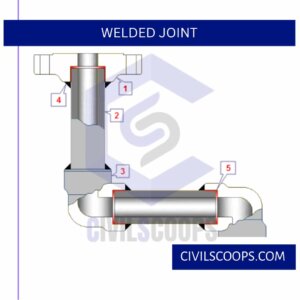
Groove welded joints, also called butt welds, are weldments that are commonly used when joining similar pipes together. They can also be used to join pipes to valves, fittings, and flanges for a secure attachment.
For piping of certain thickness, the pipe may be cut at a sloping right angle before being welded.
7. Flanged Joint
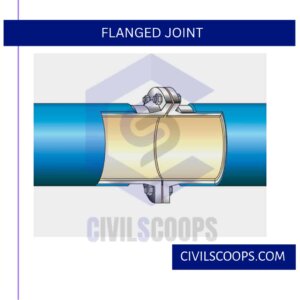
A flange is a method of connecting pipes, valves, pumps and other equipment to form a piping system. It also provides easy access for cleaning, inspection, or modification.
Flanges are usually welded or screwed. Flanged joints are made by bolting together two flanges with a gasket between them to provide a seal.
8. Compression Joint
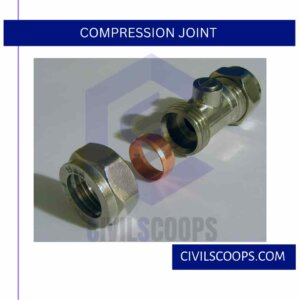
A compression fitting is a fitting used in plumbing and electrical conduit systems to join two tubes or thin-walled pipes together. In instances where two pipes made of dissimilar materials are to be joined, the fittings will be made of one or more compatible materials appropriate for the connection.
9. Grooved Joint
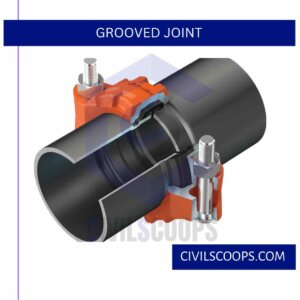
When two pipes are joined together by making grooves (narrow cuts or depression) at the end of pipes with the help of sockets or couplings, such joints are called grooved joints.
Due to the ease of assembly of the grooved joints, the labour cost is less. The piping system can be easily uninstalled and reinstalled frequently for maintenance. These are mostly used for fire protection.
10. Push-Fit Joint
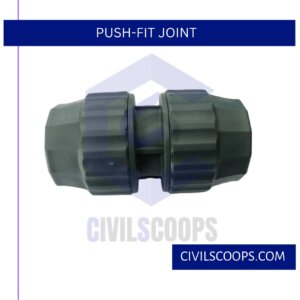
This type of joint features a toothed ring to grip the pipe and a rubber O-ring to create the seal. The end of the copper (or plastic) pipe is pushed into the joint until it hits the internal stop in the middle.
The joint can be pulled apart by pushing the ring against the joint and slowly pulling to pipe out. Push-fit joints are very quick, easy and reliable to use, but cannot be used for all applications (such as connecting directly to a boiler).
11. Hep2o Join
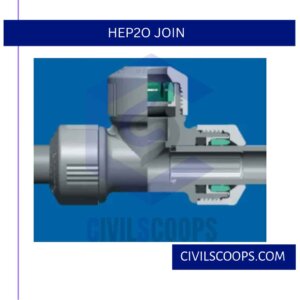
Hep2o joints are similar to compression joints but designed specifically for use with polybutylene pipes (although they can be used on copper pipes).
The pipe is pushed into the end of the joint and the cap nut is tightened, compressing the internal grab ring. Hep2o joints can be reused, but you need a special tool to release and remove the grab ring.
Supplied with a pipe insert to protect the walls of polyethene pipes. Expensive and more bulky than other types of joint.
Different Types of Pipe Joints and Where Are Use?
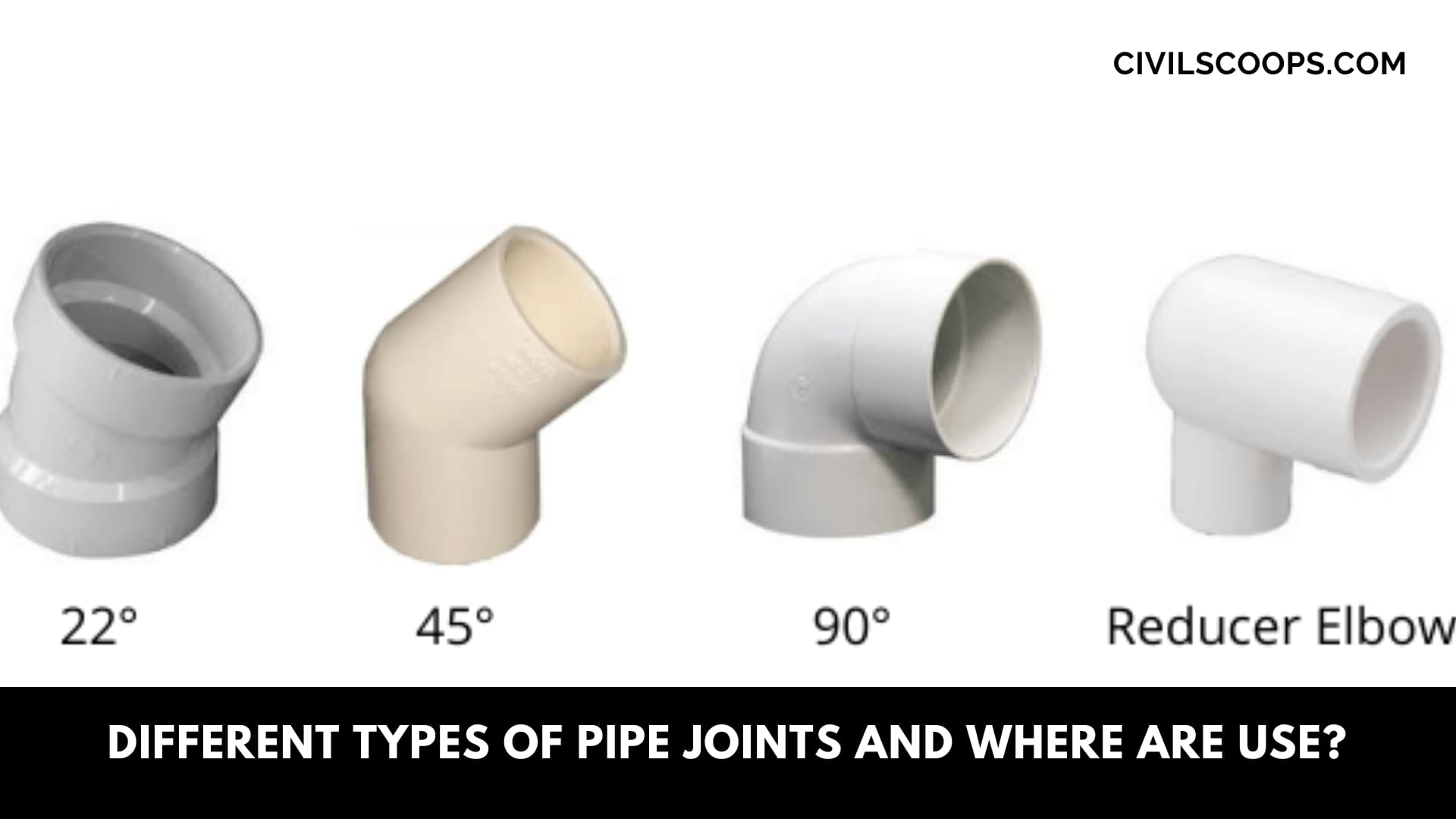
| Sr.No. | Types of Pipe Joints |
Where Are Use
|
| 1 | Threaded Joint. |
Cast iron pipes, copper pipes, PVC and G.I pipes are available with threads
|
| 2 | Brazed Joint. |
Generally used to achieve higher joint strength, Brazing is a joining process traditionally applied to metals (but also to ceramics)
|
| 3 | Spigot and Socket joint. |
Cast iron commonly used for potable water transmission and distribution
|
| 4 | Socket Welded Joint. |
small pipe diameters (Small Bore Piping); generally for piping whose nominal diameter is NPS 2 or smaller
|
| 5 | Soldered Joint. |
Used to joint copper and copper alloy pipes
|
| 6 | Welded Joint (Butt Welded, Socket Welded) |
Used to join pipes to valves, fittings and flanges for a secure attachment.
|
| 7 | Flanged Joint. |
Flanged joint design means that pipes are secured by external screws, providing additional joint support for the transportation of substances at high pressure.
|
| 8 | Compression Joint. |
used in plumbing and electrical conduit systems to join two tubes or thin-walled pipes together.
|
| 9 | Grooved Joint. |
Grooved pipe couplings can employ one of two basic styles: flexible or rigid
|
| 10 | Push-Fit Joint. |
They are fully waterproof thanks to the neoprene O-rings inside them. Push-fits are the quickest, easiest way to fit a joint – particularly for the DIYer who may not have a lot of plumbing experience.
|
| 11 | Hep2o Joint. |
Use in domestic water distribution and central heating systems including pressurised systems and combination boilers in accordance
|
Type of Pipe Joint
Types of Pipe Joints in Plumbing
- Threaded joint.
- Brazed joint.
- Soldered joint.
- Welded joint (butt welded, socket welded)
- Flanged joint.
- Compression joint.
- Grooved joint.
What Is the Best Flux for Soldering Copper Pipe?
135 is a rosin/petrolatum soldering flux paste ideal for use with copper. The petrolatum helps protect the solder joint against attack, and the rosin leaves a protective coating over the solder area after soldering.
What Is Used to Solder Copper Pipes?
Soldering Torch: Also called a soldering iron, the torch for this project is usually propane. It may also be a MAPP torch, which uses a gas that burns hotter than propane. Deburring Tool: This removes tiny jagged and uneven pieces of metal from your pipe and fitting.
How Strong Are Soldered Copper Joints?
A soldered four-inch Type L joint has a pressure rating of 440 psi. If the plumber in the field decides to braze that joint rather than solder it, the rating will be reduced to 293 psi — the annealed rating.
Soldered Copper Pipe
How to Solder a Hole in Copper Pipe?
- Follow the steps above to clean and prep your pipe.
- Apply flux around the hole.
- Heat the pipe and melt the solder.
- Clean off any drips.
- Let the patched pinhole cool before you turn on the water again.
- Replace the entire section of pipe as soon as possible.
Pipe Fitting Types
There are different kinds of pipe fittings used in piping systems. The main and most commonly sought are: elbows, tees, reducers, unions, couplings, crosses, caps, swage nipples, plugs, bushings, adapters, outlets, valves & flanges.
Copper Pipe Fitting Types
The three most common types of copper pipe used in residential and commercial construction are Type K, Type L, and Type M. A fourth type, used for drain-waste-vent, or DWV, piping, is found most often in some older homes.
Different Types of Pipe Joints
Types of Pipe Joints in Plumbing
- Threaded joint.
- Brazed joint.
- Soldered joint.
- Welded joint (butt welded, socket welded)
- Flanged joint.
- Compression joint.
- Grooved joint.
Threaded Joint
Threaded joints are defined as separable joints which are used to hold to machine parts together by means of threaded fastening such as bolt and nut.
Spigot and Socket Joint
Spigot and socket joint
Ductile iron pipe(spigot and socket joint) is a pipe made of ductile cast iron commonly used for potable water transmission and distribution. This type of pipe is a direct development of earlier cast iron pipe.
Socket Weld Pipe Joint
Socket Weld pipe joint
Socket welding (SW) is used for welding pipes and fittings including reducers, tees and elbows. Socket weld pipe fittings are used to permanently join pipes that are inserted into a recess in the fitting, flange or valve. Once correctly inserted, fillet type sealing welds are applied to join the pipe to the fitting.
Soldered Joint
Soldering (US: /ˈsɒdərɪŋ/; UK: /ˈsoʊldərɪŋ/) is a process of joining two metal surfaces together using a filler metal called solder. The soldering process involves heating the surfaces to be joined and melting the solder, which is then allowed to cool and solidify, creating a strong and durable joint.
How to Fix a Leaking Solder Joint?
Dry the outside of the elbow and sand (120-grit paper or cloth) around the leaking joint to remove all surface corrosion. Apply soldering flux around the whole joint and apply heat with a torch until the old solder melts. Add new solder until a shiny ring of solder shows all around the joint.
What Is the Strongest Weld Joint?
TIG welding is often considered the strongest weld since it produces extreme heat, and the slow cooling rate results in high tensile strength and ductility. MIG is also an excellent candidate for the strongest type of weld because it can create a strong joint.
Like this post? Share it with your friends!
Suggested Read –
- Cantilever Bridge | Cantilever Bridge Advantages and Disadvantages | Cantilever Bridge Facts
- All About Tile Popping | What Is Tile Popping | Reason for Tile Popping | How to Fix Popped-Up Tiles
- 20 Vastu Tips Before House Construction | Vastu Tips for Different Locations of House | Scientific Facts of Vastu Location of Rooms
- 20 Types of Construction Materials | What Is Building Materials List | Construction Materials List | Different Materials Used in Building Construction
- What Are Plastic Roads | How to Make Plastic Roads | Who Invented Plastic Roads | First Man Made Plastic Road | Advantages & Disadvantages of Plastic Roads